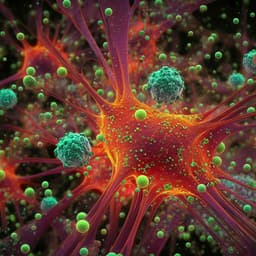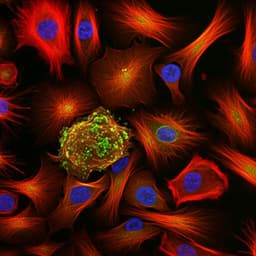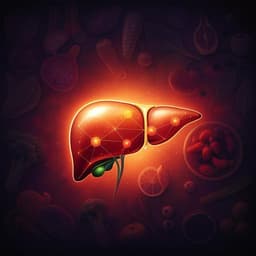
Medicine and Health
Combining single-cell RNA sequencing and population-based studies reveals hand osteoarthritis-associated chondrocyte subpopulations and pathways
H. Li, X. Jiang, et al.
Discover groundbreaking insights into hand osteoarthritis from a study using single-cell RNA sequencing. Researchers identified a novel inflammatory chondrocyte subpopulation and highlighted the crucial role of ferroptosis in this condition, potentially paving the way for future therapies. This fascinating research was conducted by Hui Li, Xiaofeng Jiang, Yongbing Xiao, Yuqing Zhang, Weiya Zhang, Michael Doherty, Jacquelyn Nestor, Changjun Li, Jing Ye, Tingting Sha, Houchen Lyu, Jie Wei, Chao Zeng, and Guanghua Lei.
~3 min • Beginner • English
Introduction
Hand osteoarthritis (OA) is a prevalent, heterogeneous joint disorder with distinct pathophysiology from knee and hip OA and substantial impacts on pain, function, and quality of life. Prior clinical trials of symptomatic slow-acting and anti-inflammatory drugs for hand OA have yielded disappointing results and no disease-modifying therapies exist, underscoring the need to elucidate underlying mechanisms. The study aims to define the cellular landscape and subpopulation-specific transcriptional changes in hand articular cartilage using single-cell RNA sequencing (scRNA-seq), and to identify key pathways and targets implicated in hand OA. To strengthen causal inference and generalizability, the authors integrate scRNA-seq discovery with population-based validation: a Mendelian randomization (MR) analysis in UK Biobank to test the causal effect of gene expression changes on hand OA risk, and a cross-sectional study in the Xiangya Osteoarthritis Study to evaluate associations at the protein/biomarker level. The overarching hypothesis is that specific chondrocyte subpopulations and iron-dependent ferroptosis pathways contribute to hand OA pathogenesis.
Literature Review
The paper situates hand OA as a distinct clinical entity with burden comparable to rheumatoid arthritis and highlights the limited efficacy of anti-inflammatory and symptomatic therapies in past randomized trials. It notes the promise of scRNA-seq for unbiased, high-resolution profiling of diseased tissues and the value of population-based studies for generalizable evidence. MR is introduced as a method leveraging genetic instruments to infer causality while minimizing confounding and reverse causation. Prior scRNA-seq studies in knee cartilage/meniscus provided markers for chondrocyte subpopulations used for annotation here. Genetic evidence linking iron homeostasis genes (e.g., HFE variants) to OA and emerging literature on ferroptosis in disease biology provide context for investigating iron-related pathways in hand OA.
Methodology
- Study design: Multi-part study combining discovery via scRNA-seq of human hand articular cartilage with validation through Mendelian randomization (MR) in UK Biobank and a population-based cross-sectional analysis in the Xiangya Osteoarthritis Study.
- Human tissue collection for scRNA-seq: Interphalangeal joint tissues were obtained from five donors undergoing forearm amputations (ethics approved, informed consent). From each donor, two specimens of whole articular cartilage were collected: one macroscopically osteoarthritic (Modified Outerbridge stage II–IV) and one non-osteoarthritic (stage 0), forming matched pairs that control for person-level confounders.
- Chondrocyte isolation and scRNA-seq: Cartilage was enzymatically digested (pronase then collagenase P) to single-cell suspensions, filtered, and processed with 10x Genomics for scRNA-seq library construction. After quality control, 105,142 cells (52,197 OA; 52,945 non-OA) were analyzed.
- Clustering and annotation: Unsupervised clustering identified 21 clusters, annotated into 13 cell subpopulations based on established markers from prior scRNA-seq studies: effector (EC), prehypertrophic (preHTC), regulatory (RegC), prefibrocartilage (preFC), fibrocartilage (FC), proliferating (ProC), hypertrophic (HTC), mitochondrial (MTC), homeostatic (HomC), cartilage progenitor cells (CPC), inflammatory chondrocytes (InflamC; novel), macrophages (Mac), and H-type endothelial cells (EndC). Comparative transcriptomic analyses with knee cartilage datasets (GSE104782) were performed.
- Statistical analyses of scRNA-seq: Subpopulation proportions were compared between paired OA and non-OA samples with Wilcoxon matched-pairs signed rank tests. Differentially expressed genes (DEGs) within subpopulations (OA vs non-OA) were identified using Seurat’s Wilcoxon rank-sum test (P < 0.05, |fold change| > 1.5). Functional annotation included GO and KEGG enrichment (topGO and standard pipelines). Gene set variation analysis (GSVA) assessed hallmark and matrisome gene sets. Gene set enrichment analysis (GSEA) tested hallmark and ferroptosis pathways (MSigDB 7.5.1) using GSEApy, reporting NES and FDR. Cell-cell communication was inferred using CellChat with permutation testing and visualization via bubble, chord, heatmaps; network roles (sender/receiver/mediator) were evaluated.
- Immunohistochemistry (IHC): Human cartilage sections underwent IHC for FTH1, iNOS, MIP-3α, IL-1β, PTTG1, and CD31 to assess protein-level distribution, with zone-specific analyses (superficial, middle, deep). Statistical comparisons used repeated-measures ANOVA.
- Comparative analysis with knee OA: Using GSE104782, the authors compared cellular proportion changes and DEGs between knee OA and hand OA, with GO/KEGG enrichment and intersections of DEGs to identify shared and tissue-specific signatures, focusing on FC subpopulation changes across OA stages.
- Mendelian randomization (MR): Two-sample MR assessed the causal effect of FTH1 mRNA expression on hand OA risk in 332,668 UK Biobank participants of European ancestry (2,418 hand OA cases). FTH1 eQTL instruments (133 SNPs) from a large eQTL study explained 65.6% of variance in FTH1 expression. Associations between SNPs and hand OA were estimated by logistic regression adjusting for age, sex, batch, and 20 PCs. Primary MR used inverse-variance weighted (IVW) random-effects; sensitivity analyses included MR-Egger, weighted median, and MR-PRESSO. Heterogeneity (Cochran’s Q) and directional pleiotropy (MR-Egger intercept) were evaluated.
- Cross-sectional study (Xiangya Osteoarthritis Study): Among 1,241 community participants (mean age 62.8 years; 50.9% female), serum ferritin (biomarker of iron stores) was measured and hand OA status determined radiographically. Generalized estimating equations (GEE) with logit link (hand-specific analysis) estimated odds ratios across serum ferritin quintiles, with crude and multivariable models adjusted for age, sex, and BMI. Trend tests were performed.
Key Findings
- Single-cell landscape: 105,142 cells from human hand cartilage (OA and non-OA) resolved into 13 subpopulations, including a novel inflammatory chondrocyte (InflamC) subpopulation marked by CCL20, CCL2, NOS2, MMP3 and enriched for inflammatory/immune processes; InflamC localized predominantly to the superficial zone by IHC.
- Subpopulation shifts: PreFC, InflamC, and FC exhibited a trend toward increased proportions in hand OA cartilage, whereas EC, MTC, and HomC tended to decrease.
- Functional profiling: InflamC and FC were enriched for inflammatory signaling (reactive oxygen species, TNFα via NF-κB, interleukin/interferon pathways). Matrisome GSVA showed distinct ECM regulation across subpopulations; FC and CPC displayed pronounced ECM gene expression changes in OA.
- Intercellular communication: CellChat suggested FC as a dominant participant in Notch and PDGF pathways interacting with endothelial cells (implicating angiogenesis). InflamC–Mac interactions involved adhesion/chemokine and inflammatory axes (e.g., ICAM1/VCAM1, IL1B, SPP1, complement), supporting an inflammation-amplifying circuit.
- DEG analyses in OA: FC in OA showed upregulation of catabolic (MMP2, MMP3, MMP13) and inflammatory genes (CCL20, CD99, TNFAIP6), with downregulation of TIMP3. InflamC upregulated several inflammatory/immune migration genes.
- Ferroptosis pathway: Upregulated genes in both InflamC and FC in hand OA were significantly enriched for ferroptosis (GSEA NES ~2.05; FDR = 0.000 for both). Core ferroptosis genes FTH1 and HMOX1 were elevated across FC, InflamC and Mac; FTH1 was consistently upregulated in InflamC and FC. IHC showed increased FTH1 protein in OA cartilage (superficial and middle layers).
- Hand vs knee OA comparison: Cellular and molecular alterations differed between tissues; FC increased in hand OA but not significantly in knee OA. Hand OA-specific DEGs were enriched for ferroptosis and oxidative stress responses, with FTH1 uniquely and significantly upregulated in hand OA.
- MR validation (UK Biobank, n = 332,668): Genetically predicted higher FTH1 mRNA increased hand OA risk (IVW OR = 1.07 per SD, 95% CI: 1.02–1.11, P = 0.005), consistent across MR-Egger and weighted median; no heterogeneity (P_Cochran’s = 0.999) and no evidence of directional pleiotropy (P = 0.491).
- Biomarker validation (Xiangya study, n = 1,241): Higher serum ferritin associated with higher hand OA prevalence (crude P-for-trend = 0.037). Highest vs lowest quintile crude OR 1.55 (95% CI: 1.08–2.22); age-sex-BMI adjusted OR 1.69 (95% CI: 1.13–2.52), adjusted P-for-trend = 0.005.
Discussion
The study addresses the gap in understanding hand OA pathophysiology by defining chondrocyte subpopulations at single-cell resolution and linking subpopulation-specific pathways to clinical risk. Identification of InflamC and FC as key subpopulations, together with their enrichment for inflammatory signaling and ferroptosis, suggests that iron-dependent lipid peroxidation and disrupted iron homeostasis contribute to cartilage degeneration in hand OA. Elevated FTH1 expression in OA InflamC/FC and increased FTH1 protein in cartilage support an iron overload response in these cells, potentially as a protective attempt to buffer labile iron that may nevertheless predispose to ferroptotic damage.
Intercellular communication analyses propose a mechanistic network wherein InflamC recruits and interacts with macrophages to amplify local inflammation, while FC engages pro-angiogenic signaling with endothelial cells, aligning with observed vascular invasion in OA. The comparative analysis with knee OA underscores tissue-specific disease biology; ferroptosis and FTH1 upregulation appear uniquely prominent in hand OA, providing a rationale for targeted therapeutic exploration.
Population-level validations strengthen causality and generalizability: MR indicates a causal effect of higher FTH1 expression on hand OA risk, and the positive association between serum ferritin levels and hand OA prevalence corroborates involvement of systemic iron status. Together, these findings support iron homeostasis and ferroptosis as central to hand OA pathogenesis and highlight potential interventions targeting ferroptosis (e.g., inhibitors) or iron chelation.
Conclusion
This study delivers a single-cell atlas of human hand articular cartilage, revealing 13 cell subpopulations and identifying inflammatory chondrocytes (InflamC) and fibrocartilage chondrocytes (FC) as key players in hand OA. Both subpopulations in OA demonstrate enrichment of ferroptosis and upregulation of iron-related genes, notably FTH1. These molecular insights were validated at scale: genetically increased FTH1 expression causally increased hand OA risk in UK Biobank, and higher serum ferritin was associated with greater hand OA prevalence in the Xiangya Osteoarthritis Study. Collectively, the data implicate ferroptosis and iron dysregulation in hand OA pathogenesis and nominate InflamC/FC and the ferroptosis axis as potential therapeutic targets. Future research should include in vivo validation, mechanistic studies of InflamC–macrophage and FC–endothelial interactions, evaluation of ferroptosis inhibitors or iron chelators, and multi-tissue, whole-joint analyses to inform disease-modifying strategies.
Limitations
- Small number of human cartilage donors (n = 5), which may limit cellular diversity capture and statistical power for subpopulation shifts.
- Lack of in vivo validation due to absence of suitable animal models for hand OA.
- Hand OA is a whole-joint disease; analyses were limited to cartilage, without concurrent profiling of synovium, subchondral bone, or synovial fluid, potentially missing inter-tissue interactions.
- Cross-sectional biomarker analysis cannot establish temporality; residual confounding possible despite adjustments.
Related Publications
Explore these studies to deepen your understanding of the subject.







